- What is Organisation Design?
- Introducing the Organisation Evolution Framework
- Consistency and Intentional Design. Building the Organisation of the Future.
- Building the Intentional Organisation
- Business Models: the theory and practice
- Strategy Frameworks: The Theory and the Practice
- Organisation Models: a Reasoned List between Old and New
- Operating Models: the theory and the practice.
- Leadership Models: The Theory and the Practice
- Purpose: The Theory and the Practice
- Corporate Culture: The Theory and the Practice
- Organisation Ecosystem: The Theory and the Practice
With this post, I explore the third element of the Organisation Design Blocks that we have mentioned, and that constitutes a foundational element of the Organisation Evolution Framework. Conceptually, the Operating Model comes after the definition of Strategy. Not a new idea. Business historian Alfred Chandler laid this out in 1962 in his book Strategy & Structure (Chandler, 1969). But is this entirely true also today? And how does the Operating Model relate to the other building blocks we have seen already: Business Model, Strategy and Organisation Model?
Note: Article updated after the original publishing date:
– April 22nd added Value-Driven Operating Models
– August 30th, typos and review of the post.
Defining the Operating Model
Setting the Operating Model through literature is not easy. The word is widely used, especially by consulting companies and in many corporate reports. There seems to “an implicit understanding of the term Operating Model” (Bateman, 2017). However, often the term is referred to many different things, adding to confusion on the concept which often is overlapping that of Operations Management. One of the issues is that academic sources that have dealt with the idea of the operating model have often approached the topic from an Information Technology discipline point of view.
Early Definitions
One of the first definitions came in a paper issued by Accenture in 2000, where the term was used as Operating Business Model (Linder and Cantrell, 2000) and defined as the organisation’s core logic for creating value. It also introduced a Framework to check the different components of the Operating Model, who would render the company unique. As you can see from the figure shown, this already seems a pretty complete model, highlighting many of the elements that are genuinely key into an Operating Model.
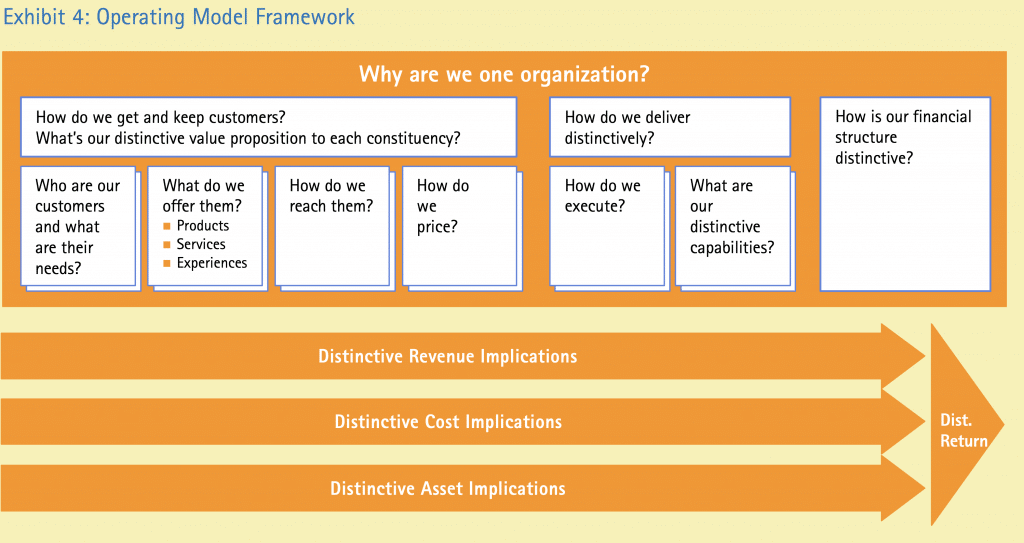
In 2005 Jeanne Ross at MIT defined the Operating Model as the necessary level of business process integration and standardisation for delivering goods and services to customers (Ross, 2005). Her view is very much derived from an Information Technology perspective, as confirmed by a subsequent book that she co-authored with Peter Weil and David C. Robertson, where the concept of Operating Model is brought near that of Enterprise Architecture (Ross, Weill and Robertson, 2006). We will come back to Ross’s model as well as to the parallel with Enterprise Architecture later in this post.
One of the most prominent experts on Operating Models is Andrew Campbell, who defines the Operating Model as follows:
An operating model is a visualisation (i.e. model or collection of models, maps, tables and charts) that explains how the organisation operates so as to deliver value to its customers or beneficiaries.
Andrew Campbell (2016)
Bain suggests a different definition: how a company organises and manages its resources to achieve its strategic ambitions (Garton, 2017). As such, it looks at creating the bridge between Strategy and execution, in a model that we will be detailing later.
Representing an Operating Model
There is generally no consensus on how to document an Operating Model (Hammond, 2014). Too often, many managers react by merely showing an Organisation Chart, but this, of course, is not sufficient. Depending on the definition we use and the model we apply, we might be forced to use different documents jointly to ensure a full picture of the whole.
Theories on Operating Models
In this section, I will try to detail as much as possible the critical theories on Operating Models. I will start with a somewhat chronological order for what concerns the academic world, then leaving to a second section the models developed by large consulting companies.
Ross Four Quadrant Model
One of the first appearance of the term Operating Model in academic literature comes from an article by Jeanne W. Ross from MIT under the title Forget strategy: Focus IT on your operating model (Ross, 2005). In this article, she introduces a taxonomy of Operating Models based on a four quadrants matrix organised on two axes: Business Process Integration and Business Process Standardization.
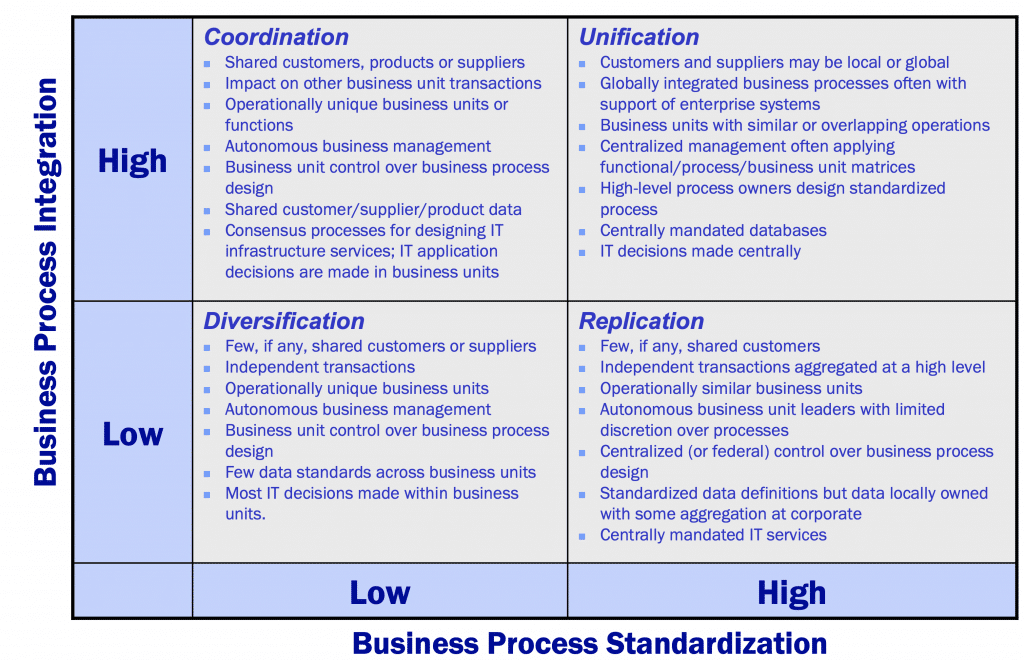
Rather than presenting a methodology to define an Operating Model, Ross provides a taxonomy of choices that existing companies had taken, and that would allow for the definition of an Operating Model within an organisation. This work has given the possibility to trace a classification of organisations depending on their position on the matrix, as well as studies on which model is more suitable for a specific market or situation.
Also, the model is derived explicitly from studies in Information Science and has expressly built a strong tie with the concept of Enterprise Architecture that we’ll examine later on.
CCPPOLDAT
CCPPOLDAT is an almost unintelligible acronym “for a cross-functional set of views used to represent an enterprise without functional, structural bias” (Winders, 2012). This model was developed and enhanced in Centrica Plc. (British Gas) from the original POLDAT framework initially created by the Computer Science Corporation CSC.
Its elements are:
- Customer,
- Channel,
- Product,
- Process,
- Organisation,
- Location,
- Data,
- Application and
- Technology.
Mostly with a focus on customer-centricity. This model can be used to describe Operating Models, although it can also be used for gap analysis and project or change impacts and baselines.
It’s essential to notice the sequence of this method, where the part of the Organisation is pretty late in the process. Ideally, this should allow for a lot more engagement building within the organisation itself. (Campbell, 2016c).
In the below video some more information on the approach.
Operations Strategy Matrix

The operations strategy matrix is a tool introduced by Slack and Lewis in their book “Operations Strategy” (Slack and Lewis, 2011). The way I see the different organisational elements, Operations Strategy seems almost an oxymoron. However, the Matrix is a handy alternative tool in the definition and identification of an Operating model. It looks at two dimensions: Performance Objectives which through Quality, Speed, Dependability, Flexibility and Cost, lead to Market Competitiveness. And a set of Decision Areas, which through Capacity, Supply Network, process Technology and Organisational Development define the Resource Usage.
The format of the Operations Strategy Matrix allows for a fine-grained presentation of the Value Proposition (Campbell, 2018) of an organisation (related to Customer mainly as it focuses on the Market as a critical Stakeholder area).
As such, it allows defining the critical components of what we can identify as an Operating Model, giving a fair view of the reality of a business as well as its choices.
The Open Group Business Reference Model
In 2014 the Open Group presented a white paper detailing a framework of reference for Enterprise Architecture work, as it tried to bring standard definitions of the various items that compose an organisation. The model goes beyond the traditionally IT-focused domains that often affect EA work and tries to bring back a holistic approach.
The resulting BRM is (Adams et al., 2014, page 7):
- Generic to the extent that it applies to organisations of all sizes within any industry, from small and agile entrepreneurial set-ups to large corporate enterprises with multiple lines of business
- Extendable across organisational boundaries to include suppliers, partners, and customers
- Customizable to accurately represent the business functions within an organisation
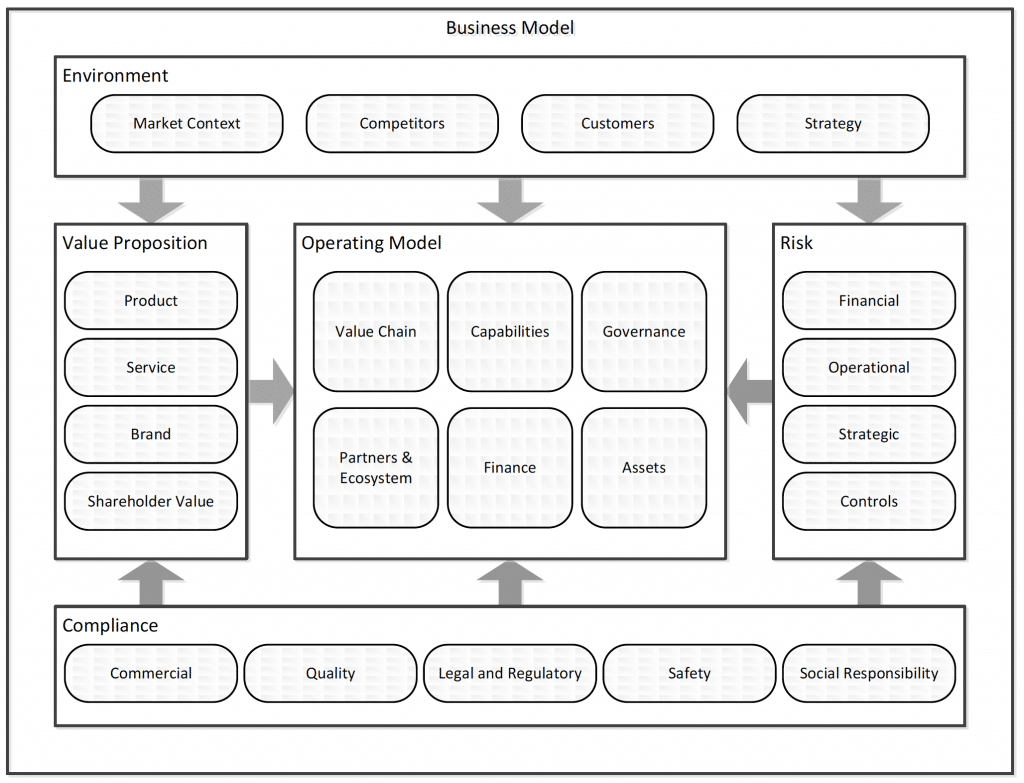
As you can see from the graphic above, the Operating Model sits at the core of the BRM and is defined as a description of “the resources at the disposal of the organisation that will be deployed to generate the value proposition. [it] is intended to describe how an organisation will be able to deliver on its value proposition. Capabilities can be thought of as combinations of people, process, information, and technology that can be internally or externally sourced“. (Adams et al., 2014, page 8)
Although this model provides an advancement over the more specialised IT related Architecture approaches, it raises some concerns:
- Value Chains are described as “the supply chain and channels to market”, but feature within the operating model and not the more comprehensive business model?
- Capabilities are described as “modular units combining people, process, technology, and information to execute particular functions of the organisation”.
- Governance is described as a set of capabilities, but Risk and Compliance feature outside of the operating model?
- Partners & Ecosystem include descriptions of capabilities and the establishment of “industry platforms”?
- Finance refers specifically to the “flows of money through the organisation” not the finance function or capability to finance the organisation?
- Assets are described as “objects that are owned by the business and are deployed to support business operations”, which potentially excludes several asset classes that would typically feature on a balance sheet? (Gray, 2015)
The Operating Model Canvas
The Operating Model Canvas is derived from the work that Andrew Campbell has done at Ashridge University and crystallised in the book Operating Model Canvas (Campbell, Gutierrez and Lancelott, 2017).
The Operating Model Canvas tool is about high-level operating models and not a detailed one. The article defines the term operating model as being about six components identified by the acronym POLISM:
- Processes – the work that needs to be done to deliver the value proposition or service proposition
- Organisation – the people who will do the job and how they are organised
- Locations – where the work is done and what buildings and assets are needed in these locations
- Information – the information systems that support the work
- Suppliers – what organisations provide inputs to the work and what sort of relationships exist with these organisations
- Management systems – the planning, budgeting, performance management, risk management, continuous improvement and people management processes needed to run the organisation
The objective of the Canvas is to capture thoughts about how to design operations and organisation that will deliver a value proposition to a target customer or beneficiary. It helps translate Strategy into choices about activities and organisation.

A core concept in the Operating Model Canvas is the concept of Value Delivery Chain. This includes defining the one or more Value Propositions that the organisation wants to offer, and the Value Chain for each of these. The author is very open about preferring Value Chain maps vs Capabilities Maps (Campbell, 2016a), although probably also here there is a question of definitions.
The SOMS Model
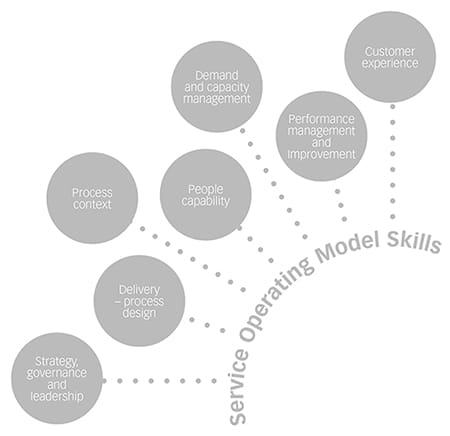
The SOMS model has been developed thanks to the work of Ian R. Hodgkinson and Rosamund Chester Buxton from Loughborough University.
SOMS uses the following definition of Operating Model:
The operating model is the operational design that makes it possible to deliver the business strategy. It is the blueprint for how an organisation operates across a range of domains to deliver its objectives (SOMS, 2017)
According to the SOMS Model, an operating model provides the architecture and framework for business operations – giving core stability with flexibility in critical areas. These are the operating model elements that need to be designed to provide flexibility, dependability and quality of service within compliance and regulatory requirements. Which is why the model is proposed as a “certification” for practitioners, a sort of toolkit that can support in the design and definition of an Operating Model itself.
The design of the operating model addresses where people and resources are located, what skills and infrastructure are required, and how the organisation monitors and improves performance. This is reflected in the seven elements comprising SOMS:
- The customer experience,
- Delivery – including process design
- Process context – organisational structure and infrastructure,
- People capability,
- Demand and capacity management,
- Performance management and improvement
- Strategy, governance and leadership.
Peter Murchland’s Model
Peter Murchland has written an interesting article on Linkedin on Operating Models, where he has brought up a relatively complete but straightforward representation. He takes his view from an Enterprise Architecture perspective (more on this later). Although the tool presented is straightforward, I have decided to include it here as there are some exciting aspects to mention.
Murchland defines an Operating Model as a way “to express how an organisation:
- pursues its enterprise
- realises its goals and aspirations
- achieves and sustains viable operation (Murchland, 2016)
He illustrates the concept through a simple design with four significant components.
He notes that “for many years, […] I have not addressed the development management system, because I was usually part of this system“. And he is the first to include Development as a vital element of an Operating Model (although others do include “capabilities”, with varying definitions). An aspect that made me think, as I genuinely believe that the Development System is also crucial in any organisation, especially as it adds an essential directional effort (which makes me think of the concept of Deliberaletly Development Organisations we have seen, as that piece is part of the Operating Model of the organisation?)
Kotter’s Dual Operating Model
In a famous article appeared in 2012 on HBR, Philip Kotter advocated for the necessity for organisations to adopt what he defined as Dual Operating Strategy.
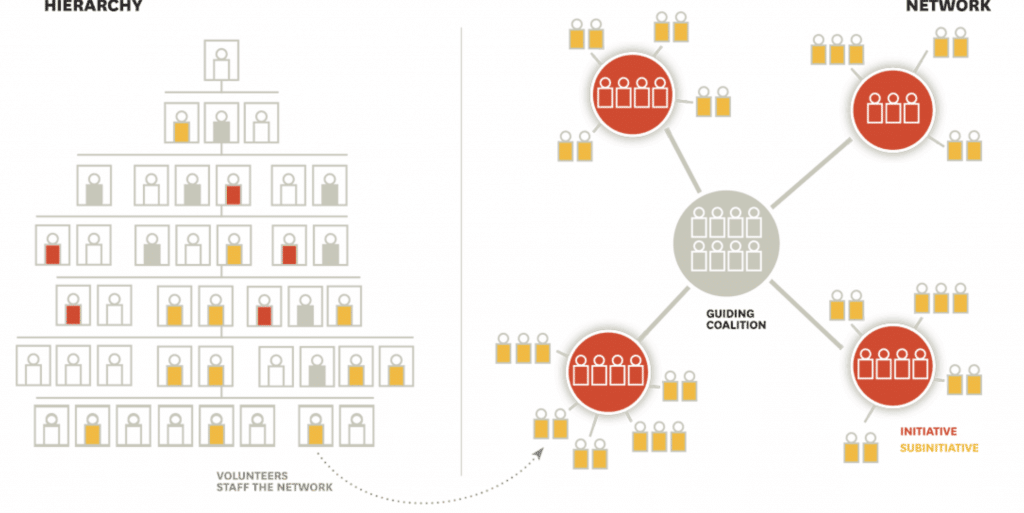
Although not providing an entirely new concept of Operating Model, his article is excellent in explaining the difference between Operating Model and Organisation Model. Two types of structures coexist in the organisation he suggests establishing, one focused on change and built as a network, the other built on a more traditional hierarchy and concentrate on the execution.
Kotter does not define the components of this model; rather he builds on what he describes as eight essential attributes that the Network structure should have to sustain accelerated change. Through the article, he, however, identifies a couple of components that make it possible for good design:
- Increase role for Leadership
- Focus on Development and Learning across the entire organisation
- “Good Enough” approach to implementation, making change faster and effective
- A new idea of “fit” and consistency across the organisation dimensions (with a higher focus on Intentionality and Simplicity).
I think this goes well in hand with what I have recently written about consistency in organisation design and the fact that, probably, too much flexibility is counterproductive.
Value Driven Operating Models
In their book, ‘The Discipline of Market Leaders‘ M. Treacy and F. Wiersema (1995) argue that no company can succeed today by trying to be all things to all people. It must instead find the unique value that it alone can deliver to a chosen market. They have identified three value disciplines that a company need to assess and define to build their unique positioning.
The particular value that you decide to offer has the effect of defining your way of thinking about your business: it shapes the company’s operating model. Different value disciplines demand different operating models in order to best capture the value that is being pursued (De Bruin, 2018). In their definition, operating models are made up of core processes, organizational structures, management systems, information technologies and culture.
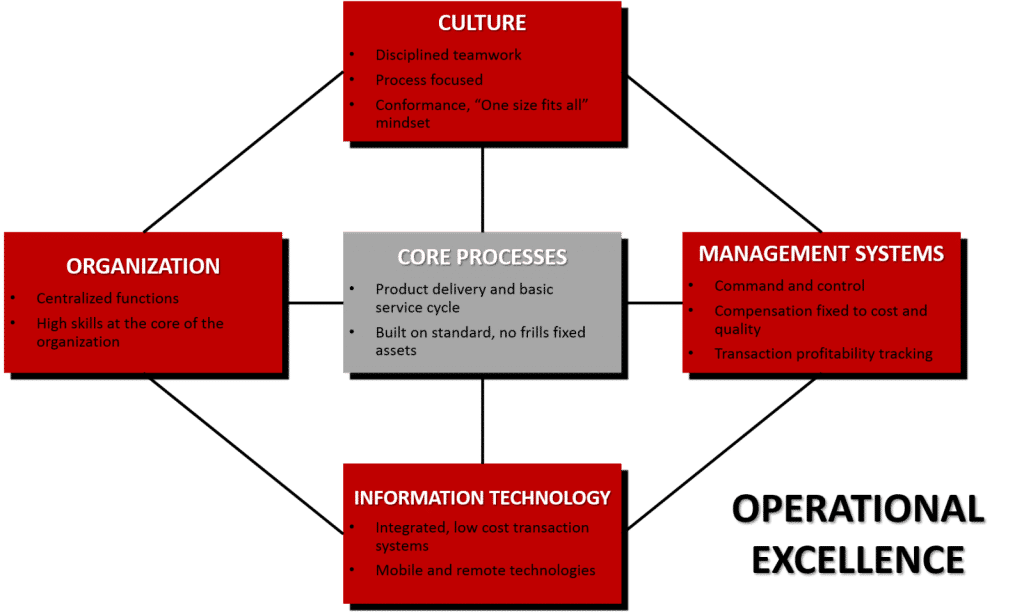
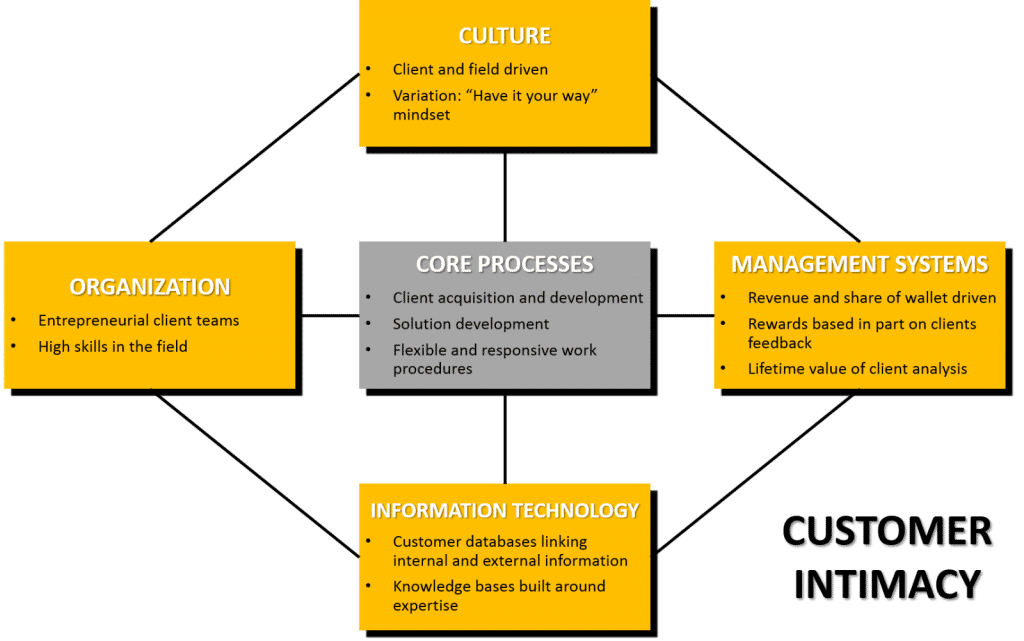
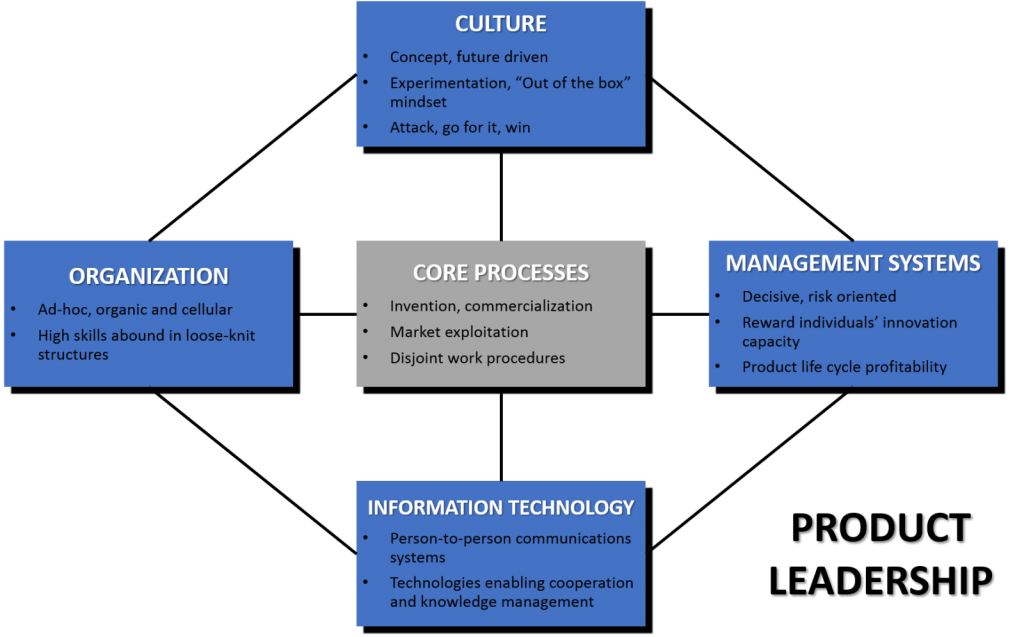



All the elements have to be adapted and aligned with the value discipline that the company decides to focus on. Therefore, each Value Discipline deserves a different Operating Model, as illustrated in the above illustrations.
Consulting Frameworks
In this section, I will try to recap the approach of the largest Consulting Companies. With one caveat, I noticed that many of these models are continually evolving in the different articles and publications that the various companies provide to their clients, showing a sort of “flexibility” in the approaches used. I list the models in alphabetical order. A few methods from smaller consulting firms are listed following the more prominent players.
Accenture
Accenture portrays several different usages of the wording Operating Model on their website. Despite being one of the first organisations in using the term (as seen before), seems that today it applies multiple approaches, depending on the target function.
In a 2017 report by AccentureStrategy, they provide a vision that is aligned in terms of the critical components of an operating Model: we see again the Op. Mod. sitting between Strategy and Execution. Accenture defines the Operating Models as “how the company is structured to execute its strategy and business model”.
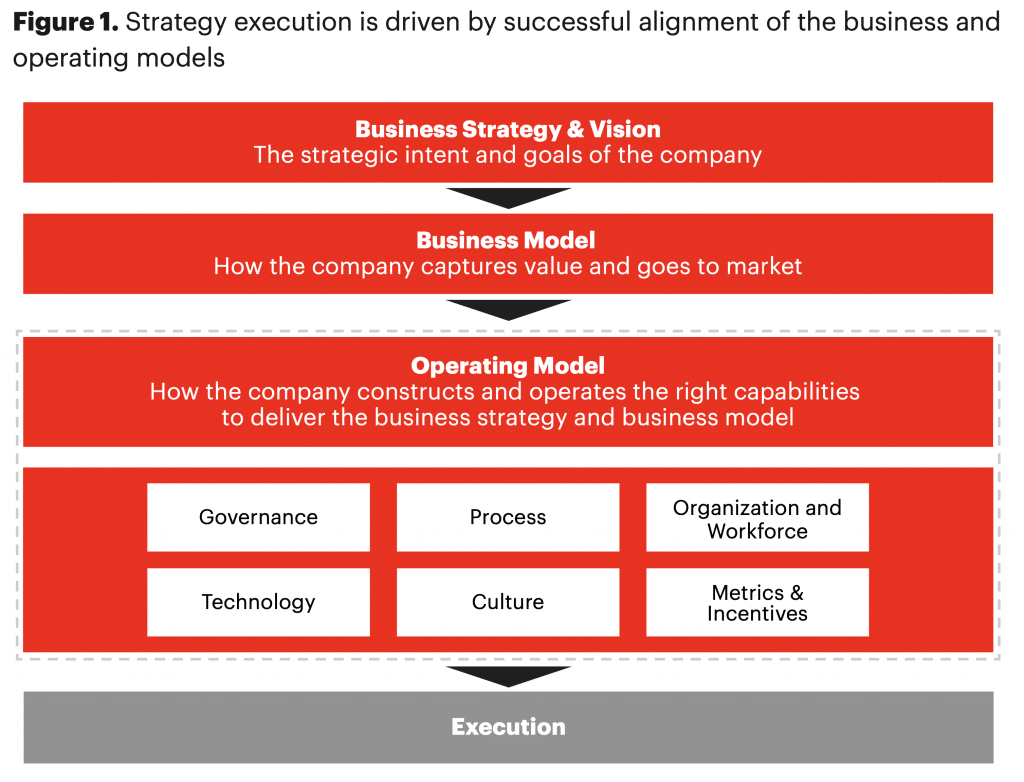
What is interesting to notice is the role of culture seen as a component of the Operating Model. Also, the paper focuses its attention on the idea of creating Domains within the organisation. Their role is to better capture value creation across the organisation through nimble teams that are more customer-focused. The notion of Domains seems to recognise that many organisations do not have an operating model that is aligned to its value drivers, and instead need to create a transversal model to capture this value creation.
In 2016 the same organisation had, however, given a much more detailed view (Dudler, Theofi and Wright, 2016). Interesting to notice the existence of a Business Case, and a Financial Frame.
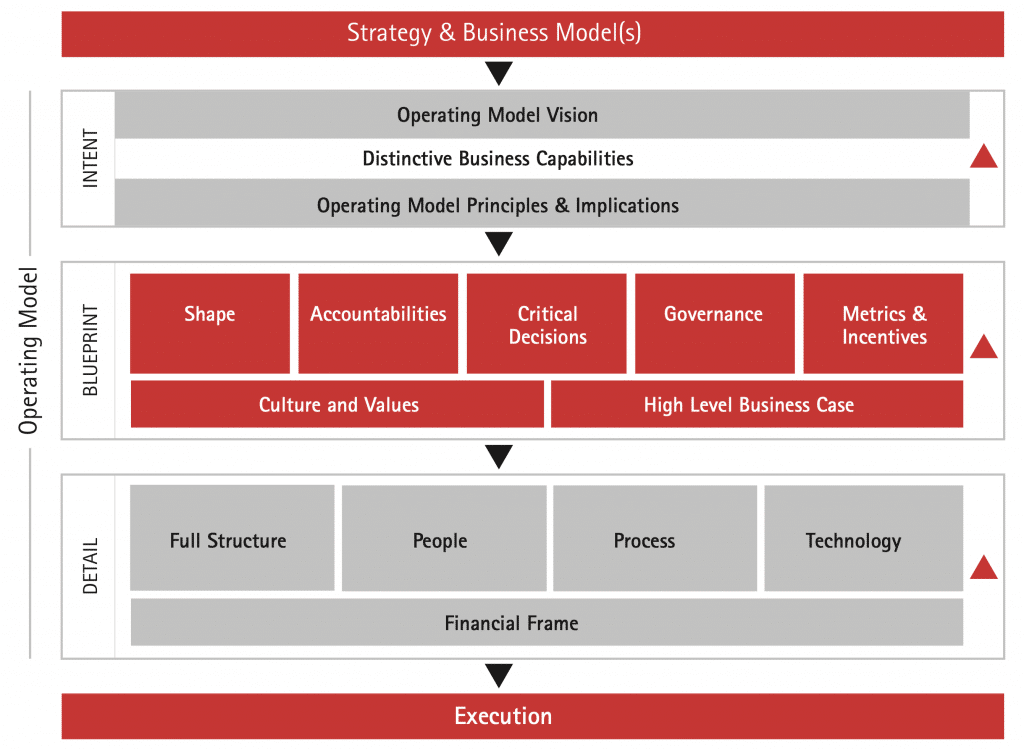
In a more recent 2019 paper, Accenture Strategy identifies five characteristics that should be embedded in “Intelligent” Operating Model Design (Bersohn et al., 2019).
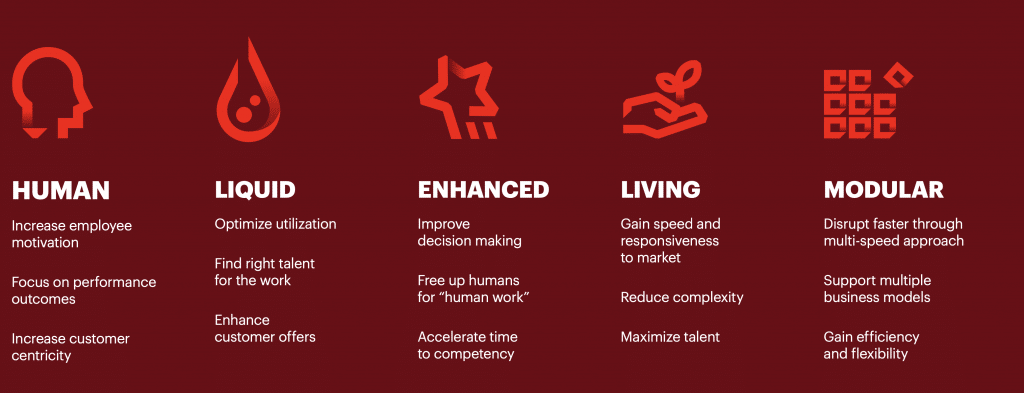
All in all, it seems that the company focuses a lot on the people dimension in its set up of the Operating Model work.
Bain & Company Model
Why so much discussion about Operating Models today? according to Bain (Blenko, Garton and Mottura, 2014), there are four issues:
- Complexity: The pursuit of growth has led to organizational complexity as companies extend to adjacent businesses and new customer segments, products and geographies. These incremental changes have accumulated over time, leading to complex organizational structures that create ambiguity and slow decision making.
- Customer experience: In many industries, the customer experience surrounding a company’s goods and services has become an important source of differentiation. This shift puts a premium on deploying frontline employees with the right autonomy, motivation and tools to delight customers—and on ensuring that the entire organization supports them.
- Technology: Digital technology has changed every aspect of business operations, including how and where companies interact with customers. The rise of collaboration technologies alters how teams interact across geographies and time zones. There’s more information flowing into and around an organization every day, and those flows don’t always respect hierarchy. Although Big Data analysis can provide valuable new insights, the growing volume of data can drown an unprepared enterprise. Relevant data must get to the right people quickly to help them make good decisions.
- Dynamic business boundaries: The best location to perform an activity or make a decision may change over time, as brands and supply chains become global and tax-advantaged models such as inversions become more prominent.
They define the operating model as an alignment of different elements. In essence, high-performing companies have set up their operating models so that organisational structure, accountabilities, governance and employee behaviours, along with the right people, processes and technology, all work together to support the strategic priorities. (Blenko, Garton and Mottura, 2014). They see the Operating Model as the element that sits between Strategy and Execution.
redesigning the operating model may be one of the smartest investments that executives can make to achieve profitable growth
Bain & Company (Blenko, Garton and Mottura, 2014)
The operating model serves as a blueprint for how resources are organised and operated to get critical work done. It encompasses decisions around the shape and size of the business, where to draw the boundaries for each line of business, how people work together within and across these boundaries, how the corporate centre will add value to the business units, and what norms and behaviours should be encouraged.
Design of an operating model starts by describing the Strategy in sufficient detail that one can articulate a set of design principles—simple yet specific statements defining what the organisation must do to enable execution of the Strategy.
Based on the design principles, the operating model takes shape through choices in five areas:
- Structure involves drawing appropriate boundaries for lines of business and defining shared services, centres of expertise and other coordinating mechanisms that allow a company to leverage scale and expertise. It also specifies the size and shape of the organization with indicative resource levels and locations. Think of this high-level org chart as the “hardware” of the operating model, with the next four dimensions serving as the “software” that makes the hardware run.
- Accountabilities describe the roles and responsibilities of the main organizational entities, including ownership of P&Ls and a clear, value-adding role for the corporate centre. There should be clear guidelines for the roles each organizational unit will play in critical decisions. A rewards framework linked to these accountabilities reinforces strong execution.
- Governance refers to executive forums and management processes that yield high-quality decisions on strategic priorities, resource allocation and business performance management. A management dashboard with the key metrics keeps the focus on the company’s top priorities.
- Ways of working describe the expected cultural norms for how people collaborate, especially across the boundaries between functions or teams. This dimension goes beyond communicating values such as “trust” and “respect” to being explicit about which behaviours make for effective decisions and execution. Establishing an appropriate decision-making style—whether through consensus, a single point of accountability or another approach—provides an important context for behaviours.
- Capabilities refer to how the company combines people, process and technology in a repeatable way to deliver desired outcomes. Where capabilities lead the design, all other aspects of the operating model must support them. In many other situations, the redesign looks first at structure and accountabilities that can only operate with the appropriate talent, processes and systems in place. In either situation, the elements are highly interdependent.
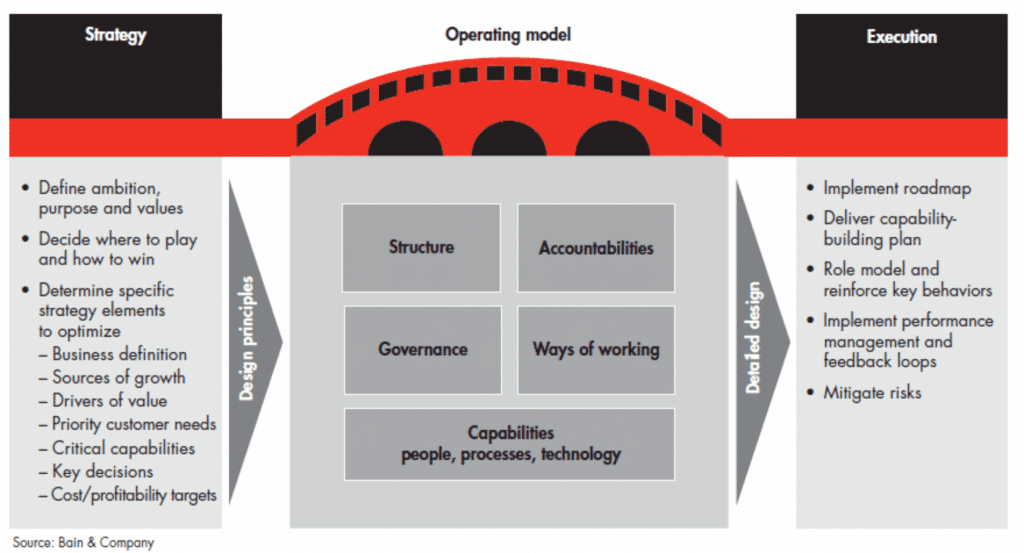
Operating model transformations often involve changing an organisation’s profile of skills and experience, which is why this intense focus on Capabilities.
The model presented is fascinating as it gives a strong focus on the Governanceside also in terms of accountabilities. A detail that not many models focus on.
BCG Agile Operating Framework
BCG released in 2018 a new view on its Operating Model approach. In an interesting article, that is focused on Public institutions and government implementations; they bridge this new model with Agile implementation.
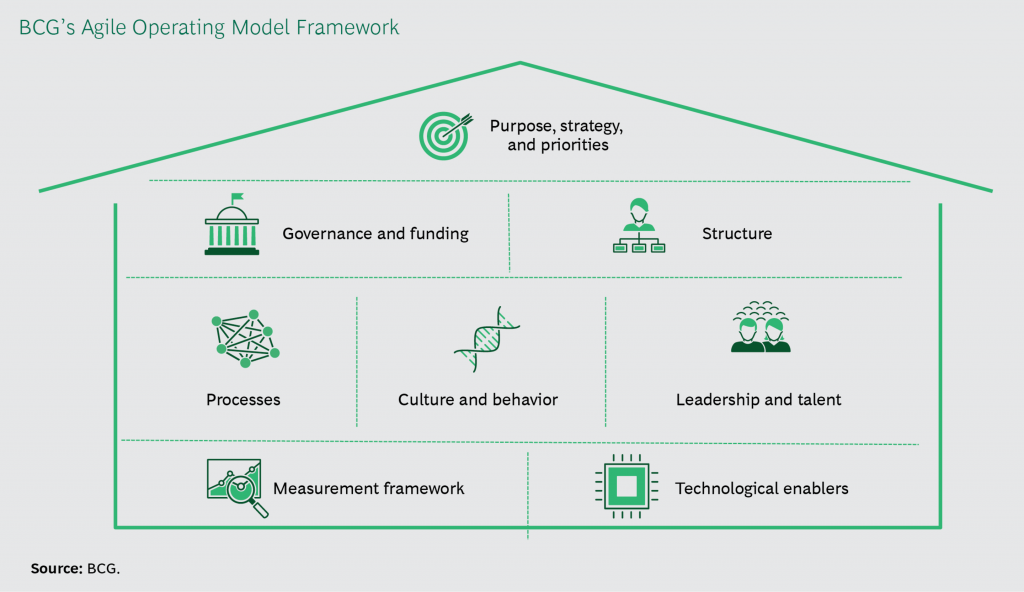
The model includes eight components:
- Purpose, Strategy, and Priorities. Agreement on these is essential before an organization can allocate resources appropriately and start to build the infrastructure that agile calls for. Ensuring that everyone is clear on purpose and strategy and understands why and how the organization must change is critical to enabling autonomy at all levels.
- Governance and Funding. Organizations should move to a more flexible, capacity-based funding approach, with regular reevaluation of initiatives to ensure that they are on track and merit continued funding.
- Structure. Flatter organizations with wider spans of control and clearer accountability and ownership of programs empower the workforce to take responsibility for decision making and problem-solving. Line managers then become coaches and facilitators rather than bosses.
- Processes. Cross-agency coordination, cross-functional teams, and close cooperation with citizens are essential to flexible, multidisciplinary ways of working.
- Culture and Behavior. At the heart of an agile transformation is a change in culture and behaviour. Agile prioritizes autonomy at all levels and empowers teams to experiment with alternative solutions to problems. But autonomy can descend into chaos unless teams at all levels are clear on purpose and strategy. That depends on strong leadership and clear and frequent internal and external communications.
- Leadership and Talent. Besides hiring and promoting top talent, organizations must base rewards on outcomes and peer feedback, with a focus on developing expertise and new career paths—practices that have yet to be widely adopted in the public sector. Leaders need a comprehensive understanding of the mission, purpose, and underlying principles of the transformation in order to ensure that teams at all levels are clear on the “why”—the organization’s strategy and purpose. Then they need to let go, abandoning traditional command-and-control models and allowing teams to figure out the “how.”
- Measurement Framework. To assess progress toward goals, data analytics should be more widely deployed across the organization. Transparency in measurement frameworks is essential and can be achieved by using digital tools and analytics to empirically assess and track improvement. Critically, data must be widely available throughout the organization.
- Technological Enablers. Agile requires a transition from heavy mainframe to more modular systems that give teams greater ownership of their end-to-end processes. Essential elements include the use of APIs (application programming interfaces); shared tools to manage the flow of work from idea through development and into customers’ hands; continuous delivery, automated testing, and DevOps (which unifies software development and operation); and defined technology architecture that identifies the data important to the organization and the systems that create and manage it (Carrasco, Geluk and Peters, 2018)
It’s interesting to notice the focus that BCG puts on Leadership, as well as on Funding. This is usually an element that does not appear in most models. Still, it should be taken into consideration as the cash flow that is necessary to sustain activities is particularly relevant when we are designing an Operating Model for one are of an organisation.
Deloitte’s Model
Deloitte makes the concept of defining a Target operating Model critical in most of its change approaches. This is why it is interesting to see a lengthy article published in 2019, specifically on Architecting Operating Models. I have already cited this work in my post that clarifies the critical components of Organisation Design, but we will now focus on the Operating Model dimension.
Operating Models are defined as a representation of “how value is created by an organisation—and by whom within the organisation” (Kwan, Schroeck and Kawamura, 2019). An example of an Operating Model is illustrated below.
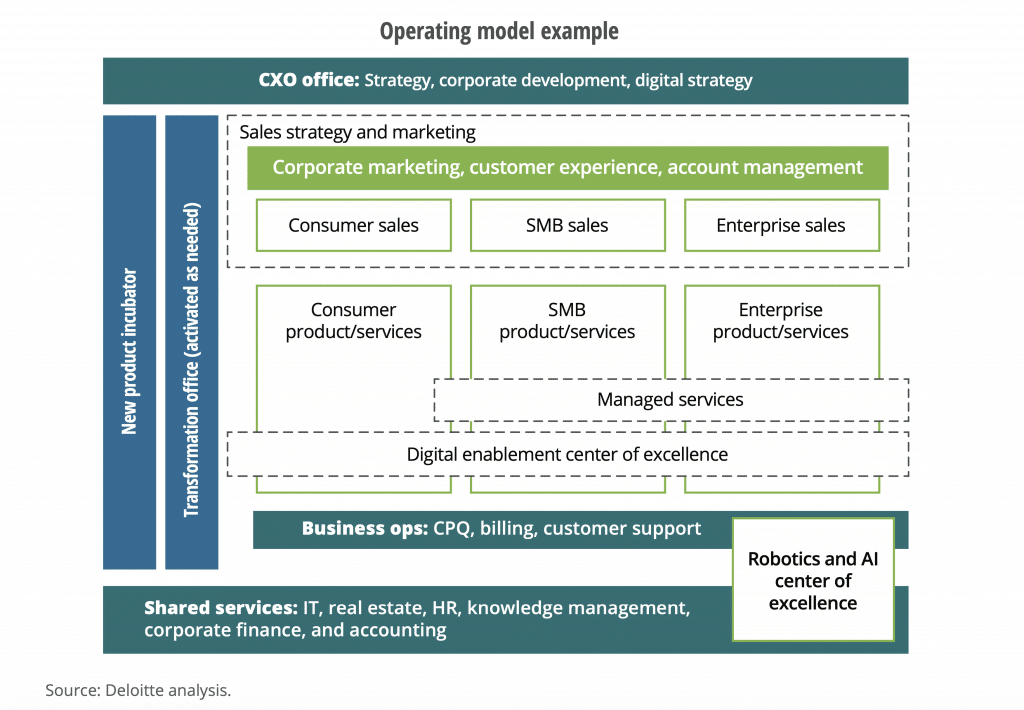
Leaders should develop a clear sense of their strategic ambitions—where to play and how to win—and the business models they wish to employ, including target customer segments, channels, pricing, and delivery models, since both the strategy and business model directly influence the operating model design. Organizations that try to short-cut their way to a new operating model may find the design to be ineffective and the implementation lacking employee traction—or, worse, dilutive to value.
Deloitte (Kwan, Schroeck and Kawamura, 2019).
The development of an Operating Model comes by answering four critical questions:
- What work needs to be done?
- Where does the work get done?
- Who does the work?
- How do we drive better outcomes?
It is immediately apparent that the model focuses a lot on Capabilities as well as on the resulting execution. It is interesting to notice that most of the questions above would generally find an answer through a typical Strategic Workforce Planning exercise. But it is the Capability Map exercise which, at its core, is what we have so far defined as Operating Model. As you can see and recognise most of the components. Also, the authors define Capability as something that Creates Value for the organisation, thus bringing us back to the concept of Value Chain.
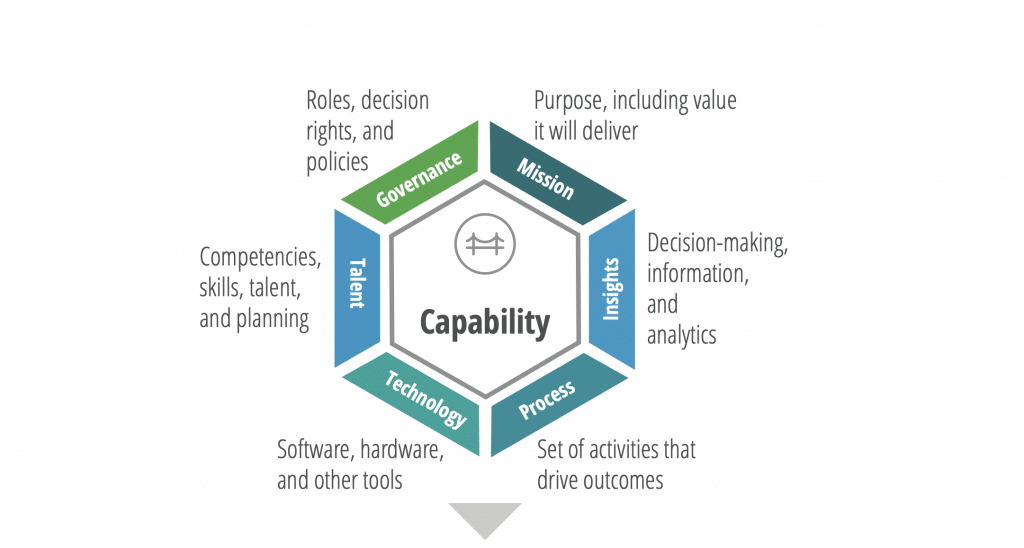
All in all, this model includes again all critical components we have seen so far and yet supports the bridging of Strategy and Execution. It is interesting to focus the role that work has in this model, in its more ample definition. Choosing how work gets done (for example, is it automated?) is a critical formal element of the Operating Model according to this approach, something interesting to consider.
KPMG Target Operating Model
KPMG has the most limited and narrow view on the concept of Operating Model, although it places it at the core of its Powered Enterprise concept. In this case, the Target Operating Model is defined as a “toolkit” that “shapes how transformation plays through every layer of your organisation” (KPMG, 2020)
The six layers that are provided as part of this toolkit reflect some of the standard components we have already seen in other frameworks. Interesting to notice the presence of a Service Delivery Model defined as “how things get done”.
The McKinsey Model
In a ponderous volume published in 2017 and dedicated to the new digital organisation, McKinsey takes a defined view on Target Operating Models as part of a Digital Transformation trajectory (Dias et al., 2017). This is to be achieved through a path that goes through the adoption of a Next-generation operating model based on Customer Journeys, an interesting idea.
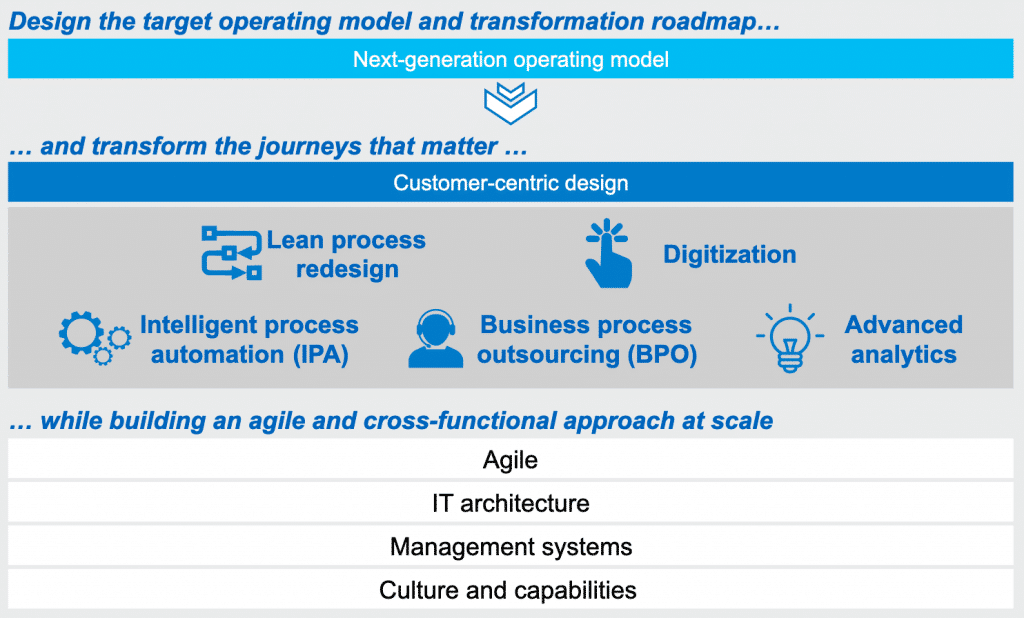
A framework is not fully explained, but five approaches are identified in the design process.
- Digitisation is the process of using tools and technology to improve journeys. Digital tools can transform customer-facing journeys in powerful ways, often by creating the potential for self-service. Digital can also reshape time-consuming transactional and manual tasks that are part of internal journeys, especially when multiple systems are involved.1
- Advanced analytics is the autonomous processing of data using sophisticated tools to discover insights and make recommendations. It provides intelligence to improve decision making and can especially enhance journeys where nonlinear thinking is required. For example, insurers with the right data and capabilities in place are massively accelerating processes in areas such as smart claims triage, fraud management, and pricing.
- Intelligent process automation (IPA) is an emerging set of new technologies that combines fundamental process redesign with robotic process automation and machine learning. IPA can replace human effort in processes that involve aggregating data from multiple systems or taking a piece of information from a written document and entering it as standardised data input.
- Business process outsourcing (BPO) uses resources outside of the main business to complete specific tasks or functions. It often uses labour arbitrage to improve cost efficiency. This approach typically works best for manual processes, are not primarily customer-facing, and do not influence or reflect critical strategic choices or value propositions. The most common example is the back-office processing of documents and correspondence.
- Lean process redesign helps companies streamline processes, eliminate waste, and foster a culture of continuous improvement. This versatile methodology applies well to short-cycle as well as long-cycle processes, transactional as well as judgment-based processes, client-facing as well as internal processes.
Although none of these items is new, it is interesting to see them in the context of Operating Model Design. And again, another focus on the key concept of Work as a component of the Operating Model.
PWC’s Operating Model Blueprint
Also, PWC has its own framework for an Operating Model. “An operating model bridges the gap between an organisation’s business strategy and its operational resources” (PWC, 2012).
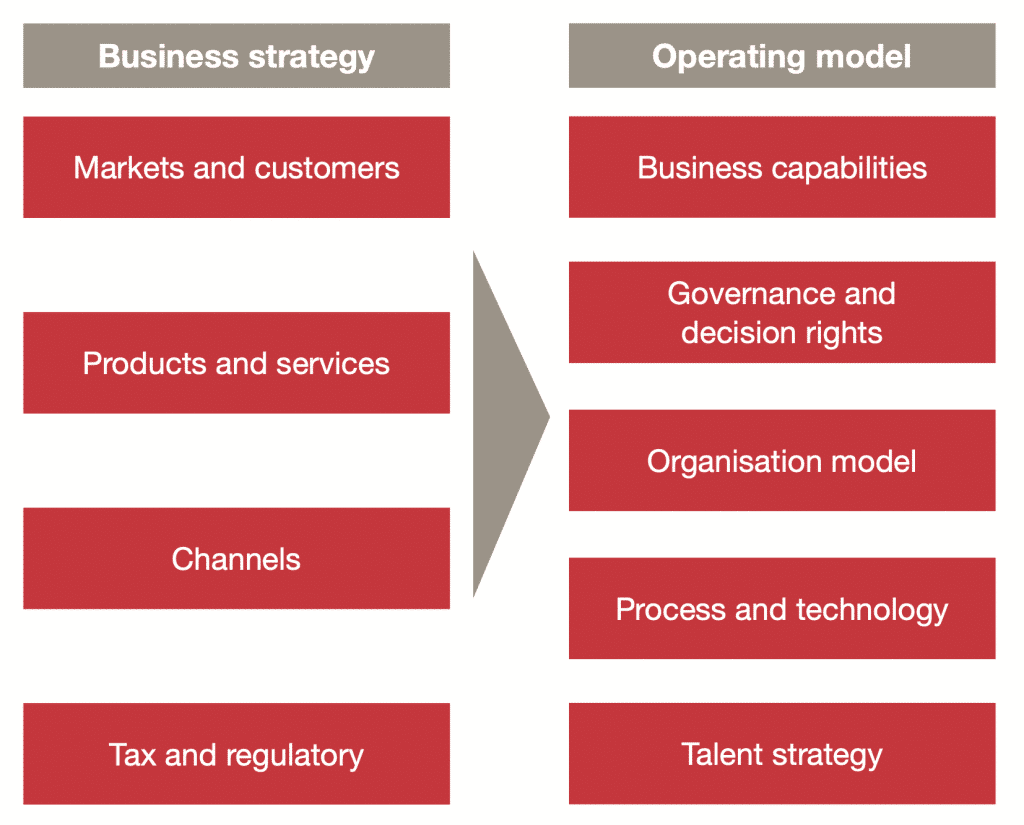
The paper makes a clear distinction between Business Strategy and Operating Model. It defines a path to represent each of the five identified components through a checklist of questions and actions. The goal of an Operating Model should be that of promoting adaptability of the organisation, and flexibility in achieving value for its customers.
More recently PWC has presented a new Operating Model Blueprint which delivers a somewhat evolved view. Also here, we can notice the concept of capabilities, and the definition of Tools and Technologies as Way to Play.
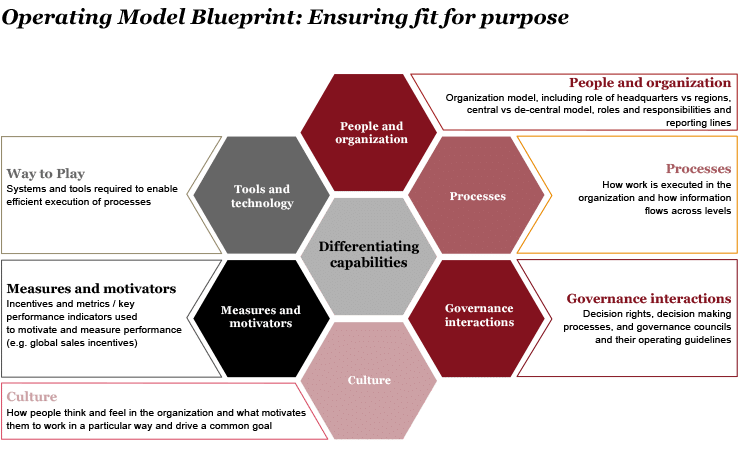
FromHereOn Design Model
FromHereOn is a consulting firm specialised in Business Design. As part of their Business Design Method, they highlight a specific role and approach for Operating Model Design. I am highlighting this model here because it introduces a few interesting concepts.
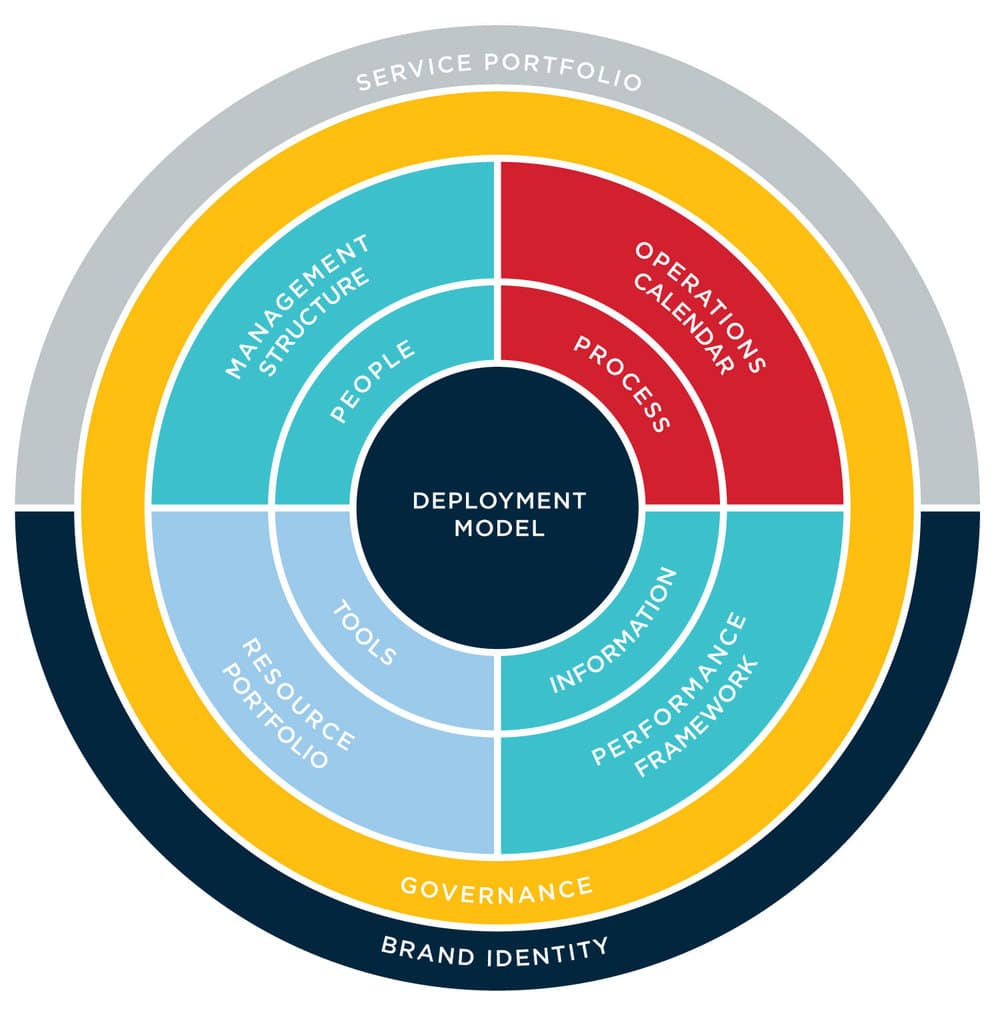
The model highlights the Capabilities required by the organisation, as well as its Deployment Model, which essentially identified which business capabilities are available where.
Two components that are interesting to highlight, as we’ve not seen them before, are the Service Portfolio and the Brand Identity. The latter is considered as the personality of the business and is required for the delivery of value to the customer. The first is instead the catalogue of Services that the organisation provides.
An interesting and complete model that focuses intimately on the value delivery by the organisation as it executes its Strategy.
Operating Model and Enterprise Architecture
We have already seen that a lot of the academic research around Operating Model has been derived from Information technology, and often there is a somewhat overlap between the concept of Operating Model and that of Enterprise Architecture.
I don’t want to go too much in detail here, but it is interesting to point out that both approaches wish to describe the “architecture” of the organisation. Both want to enable execution; the sole difference is that Enterprise Architecture is focused on Information Flows across the organisation (but not only…), whereas Operating Model, as we have seen, looks at the entire Value Chain.
According to Murchland, Enterprise Architecture involves looking for:
- the explicit models that the enterprise is using to describe itself or its intended self
- any gaps or inconsistencies that might be evident in these models
- any gaps or differences between current capability and advanced capability represented by these models
- any gaps or inconsistencies that might be evident between the implicit models that are evident in how leaders think, communicate, decide and act and the explicit and then developing a more integrated set of models on which to base an assessment of capability gap and a transformation plan to address the priority gaps. (Murchland, 2015)
The logic of how Enterprise Architecture works is pretty similar to the definition of an Operating Model. You usually try to map the As-Is model, plan a To-Be future model aligned with the corporate strategy, and then through a Gap Analysis, identify the steps that are necessary to achieve results.
So if there is this overlap, why is it that in some companies we both have an Operating Model and an Enterprise Architecture developed in isolation?
In an interesting article co-written by Campbell and Murchland (2015), several reasons are identified:
- First, there is a language barrier. As EA is born from IT, there is a specific usage of words. For example, the term capability is widely used in EA, to simply highlight any activity that needs to be done by the organisation, while business leaders would typically focus on distinctive capabilities.
- Second, EA expert often “don’t speak the business language”. There is often the idea that EA experts don’t understand the business or the Strategy of the company, and get lost in what seems technical jargon. On the other side of the spectrum, many Organisation Design experts miss the technical skills to understand the technical aspects that underpin an organisation technology. We see the creation of siloes again.
- Third, the attention to detail: paying tribute to their technology origins, EA experts often go a long way to detail (and document) all the minuscule aspects of each architecture element. They are resulting in the production of enormous materials, challenging to maintain.
Many of the models of Enterprise Architecture, and the standards that underpin these, would be beneficial to be also applied to Operating Model design, as they share the ultimate intention, as well as some tools. I think it would be great to work more on aligning these two aspects, in another effort to align HR and IT as much more continuous domains that it seems. Fusing Organisation Design and Enterprise Architecture can deliver genuine added value, as illustrated from the graphic below.
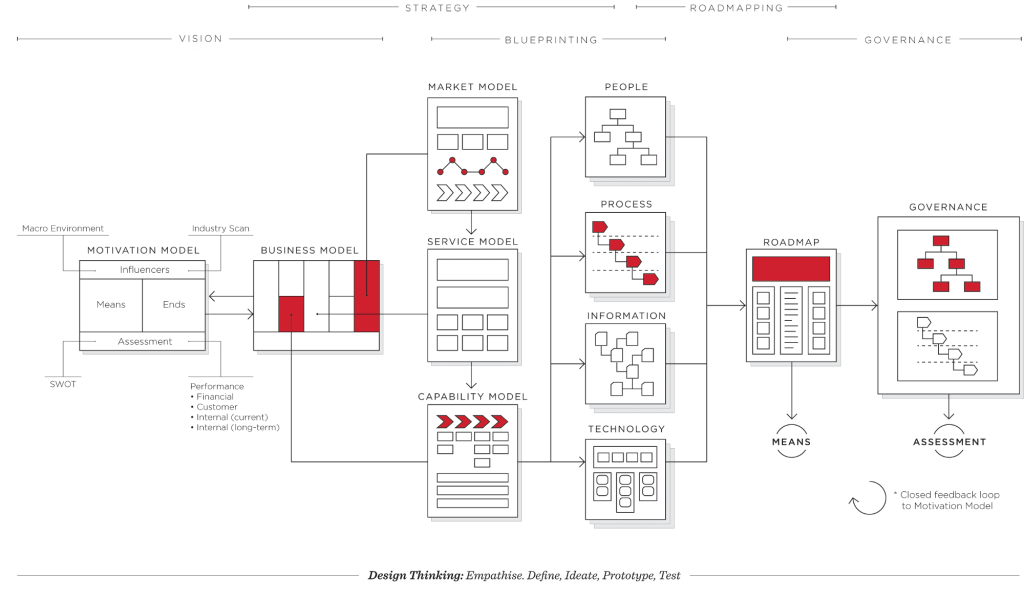
How to use Operating Models
We have now read much content on the different conceptual frameworks that exist around Operating Models. But how do we use them? Despite differences in content, I believe that most models can work, if applied in the correct context.
I see three main usages for an Operating Model.
- Understand your Organisation: too often, organisations never sit and reflect on their Operating Model. This just gets formed as a result of the organisation operations and performance. The typical document you can find is an org chart, but as we have seen, this only tells a part of the story. So it is essential to look at how real the organisation exists. Value Chains are probably the best tool to map an existing organisation, also because they don’t need enormous efforts in terms of documentation, and have high value in identifying low-value activities performed by the organisation.
- Test Your Organisation Design: once you understand your Operating Model, you can test if it is suitable for your organisation strategy. Way too often the OrgChart might seem aligned with what your organisation wants to achieve, but it is abysmal in the information. There are multiple tests that you can drive to check the effectiveness of your business and see if this is well designed (Goold and Campbell, 2002).
- Drive Change if you plan to design a Target Operating Model, you can use the typical approach of identifying the To-Be, run a Gap Analysis and define the best path to achieve. This will also provide a future vision, useful to then truly drive change.
- Architecting for Innovation stemming from the mentioned idea of Kotter, this is about intentionally designing your Operating Model so that it caters for innovation and not just execution. This can help balance the need for consistency as well as the demand for that energy creating friction that can profit your organisation and deliver more creativity.
Conclusion
After having written about Business Models and Organisation Model in detail, this article has taken a lot more time in its writing. Probably it is around the concept of Operating Model that there is more “confusion” on what it means. Strange, especially considering that any organisation has an Operating Model, it just often is not written down.
Part of the problem is linked, in my experience, to the equation Operations = Operating. In many companies that have adopted the role of a COO running all Operations, as opposed to the Business Functions, creating a cleavage in concepts that have created a distance in the understanding of this vital component.
As an HR professional that navigates organisation Design, I spend hours in letting managers understand the importance of defining an Operating Model ina change process. And I always end up having to discuss that no, it is not an organisation chart.
If the Business Model represents the unique way in which you conduct your business, the Operating Model represents the organisational DNA. Few essential components (Processes, People, Technology, Governance) that can be assembled and reassembled in multiple shapes and forms, each originating a truly unique organisation.
Operating Model within the Business Evolution Framework
I’ve recently introduced a Visual Framework that allows visualising all essential building blocks of Organisation Design. Here below the representation of Operating Model with its definition and the Critical Element that derives from it: Value Delivery Chain.
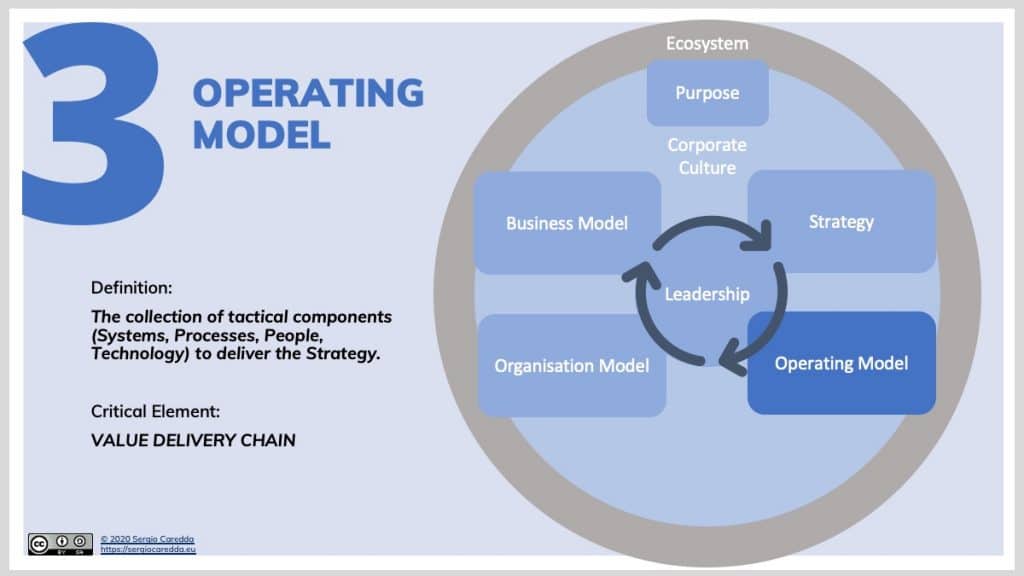
It is defined as The collection of tactical components (Systems, Processes, People, Technology) to deliver the Strategy.
Introducing the Organisation Evolution Framework
Visual representation of Organisation Design building blocks and their dynamic relationships.
Now released in Version 2, open for feedback.
As usual this article is open for feedback and suggestions.

Cover Photo by Sergey Zolkin on Unsplash


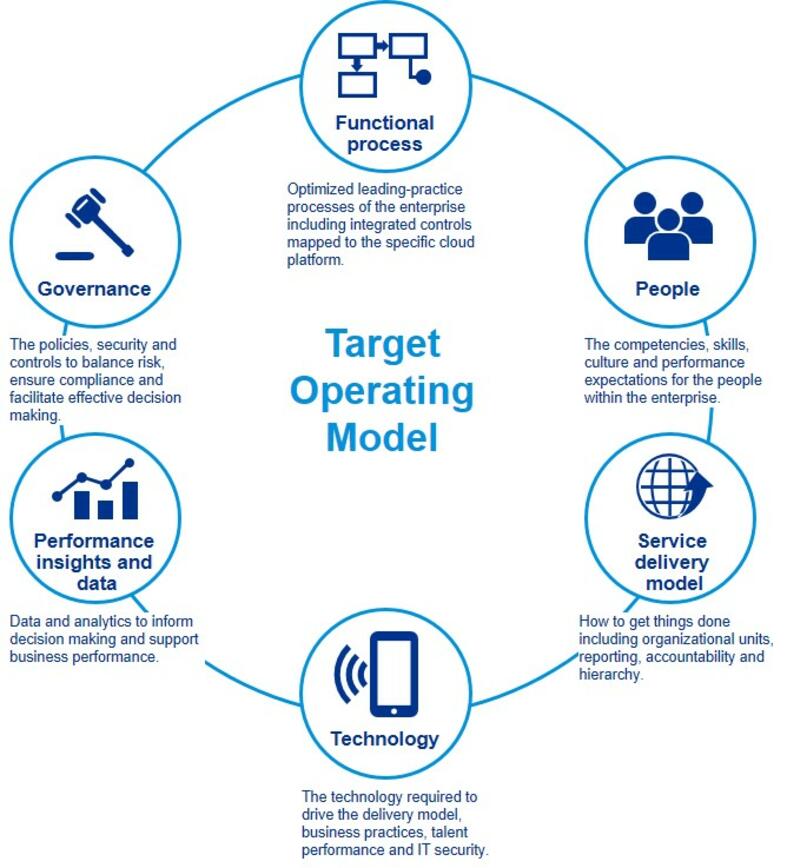
[…] Operating Models: the theory and the practice. […]
[…] Operating Models: the theory and the practice. […]
[…] Operating Models: the theory and the practice. […]
[…] Operating Models: the theory and the practice. […]
[…] Operating Models: the theory and the practice. […]
[…] of the comments that I got on LinkedIn on my article on Operating Models, stated that it’s easy to reflect on any of these components when you are building a new […]
[…] The Operating Model […]
[…] of the comments that I got on LinkedIn on my article on Operating Models, stated that it’s easy to reflect on any of these components when you are building a new […]
[…] Operating Models: the theory and the practice. […]
[…] Operating Models: the theory and the practice. […]
[…] Operating Models: the theory and the practice. […]
[…] Operating Models: the theory and the practice. […]
[…] Operating Models: the theory and the practice. […]
[…] Operating Models: the theory and the practice. […]
[…] Operating Models: the theory and the practice. […]
[…] https://sergiocaredda.eu/organisation/organisation-design/operating-models […]